- This photo feature tells you in brief
about the history of Turtuk, how it became part of Bharat, meeting with the
erstwhile ruler and the origin of the Balti people.
We were standing at Thang, a tiny remote village, on one of the Northern most points of India. A deep, thickly forested Ravine – lead to the Indian Army Outpost dotted with Army Bunkers. Indian soldiers were at eyeball to eyeball distance from their Pakistani counterparts. An Indian Flag marked the ground where we stood.
The Line of Control (“LOC”) was shorn of all the drama and jingoism of the Wagah Border.
Local Baltistani village women lent us
binoculars for viewing the border posts and the area under Pakistani control. We
scanned the Pakistani village-in a vain and futile attempt to confirm whether the
Indian side looked more prosperous. As a show of solidarity for the local Balti
people, we bought some fresh Apricots that were really nice.
The twin villages of Thang (in India) and
Pharnu (in Pakistan) which were intertwined, like brother and sister or parent
and child, suddenly separated on the night of 16th and 17th
December, 1971. The umbilical cord that bonded these two villages was severed.
People who had lived there for two thousand years, now had a separate identity.
The inhabitants who probably had never known or even understood the concept of
a nation were now either Indian or Pakistani.
Amidst rugged mountains and terrain, at the confluence of the World’s highest Mountain Ranges – the Himalayas and the Karakoram – is the region of Baltistan, which is predominantly under Pakistani occupation and control.
The region is home to several towering peaks,
kissing the skies at well over 23000 ft above sea levels. Nature is an Omnipotent
force here. Living amongst gigantic stony mountains, biting winds and temperatures
that drop to -20 C, can make life a living hell. The landscape provides limited opportunities
for farming. Fruit trees like Apricots and Walnuts are amongst the only forms
of vegetation there.
The Balti people, originally Buddhist
when they migrated from Tibet, were converted to Islam by the end of the 15th
Century and are predominantly Shia. Customs and traditions are a mix of Tibetan
and Islamic. The Balti language, which is similar to Tibetan and Laddakhi, incorporates
words of Urdu.
Our next halt was the Yagbo Palace.
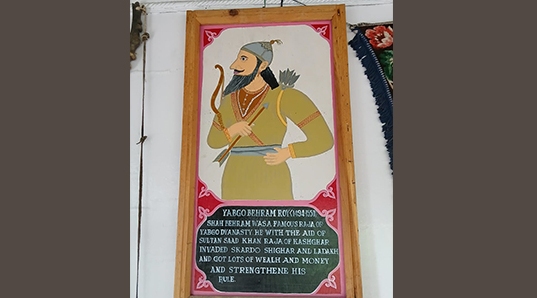 Founder of the Yagbo dynasty. Picture on palace wall.
Founder of the Yagbo dynasty. Picture on palace wall. It is a modest dwelling made out of
local woods. Luxurious carpets lined the floor. Photographs, artefacts and
swords adorned the walls, whispering the glorious history of the Yagbo kings.

 Palace
external.
Palace
external. We were ushered into the presence of an old
gentleman, with a regal bearing, a handsome face with creases that resembled
the ruggedness of the mountains, in long flowing white Robes and a Walking
Stick with intricate carving. He bore a stern expression with no pretence or attempt
at amicability. The noisy touristy chatter turned into a stark silence. The
groups attention swung in his direction with bated breath, as if we were about
to witness the unfolding of a spectacle.
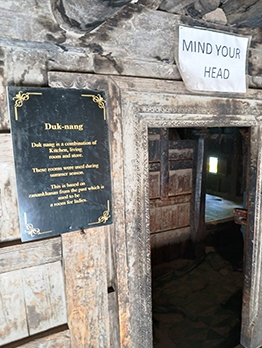 Duk Nang room was the living room in the Yagbo Palace.
Duk Nang room was the living room in the Yagbo Palace.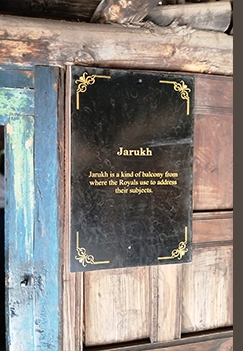 Jaruk was the room from where Royals addressed their subjects.
Jaruk was the room from where Royals addressed their subjects. The gentleman in a mix of English and
Hindi explained the history of the Palace, built by Raja Turab Khan in the 16th Century. It was built using the most basic, rudimentary tools and technology. Wood was the main building material. The old gentleman patiently described the history of the palace and Baltistan. The Yagbo Family ruled a little kingdom for over 500 years, which encompassed lands on both sides of the LOC. It was annexed in the 1840’s by Dogra ruler Raja Gulab Singh, thus came under the suzerainty of Jammu and Kashmir.
 Author with family in palace courtyard.
Author with family in palace courtyard. We could sense that this was no ordinary
old man trying to make a living. After some gentle prodding, he revealed
himself as Mohammed Khan the current king of the Yagbo Dynasty.
 With the current king of Yagbo dynasty.
With the current king of Yagbo dynasty.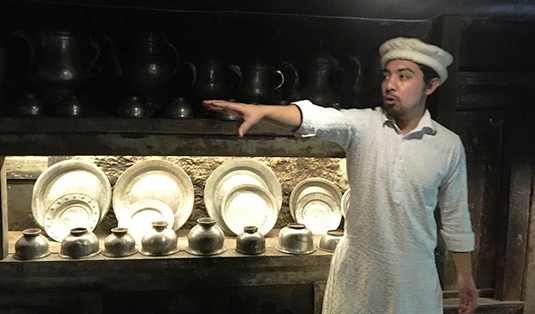 Inside palace. Local explaining
Inside palace. Local explainingThe palace and the surrounding villages
were part of Pakistan Occupied Kashmir from 1948 to 1971, when the Indian Army annexed
it. The palace was used as HQ of the Pakistan Army for the region till
1953.
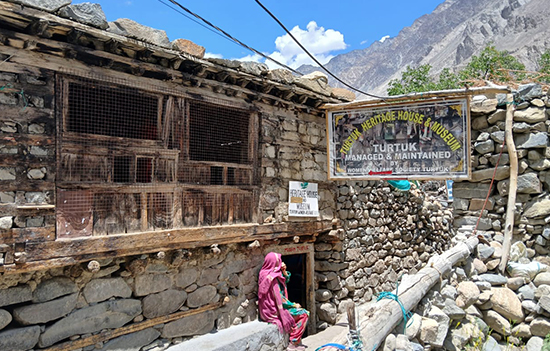 Entrance to Turtuk Heritage House.
Entrance to Turtuk Heritage House.Our next stop was the Turtuk Heritage
House. A small spartan house of about 150 sq ft. it was home of the former
Sarpanch. The house was dark and depended
on natural light that crept through the crevices in the walls. The walls were
lined with all the requirements of daily living such as pots, pans, hookahs,
shoes, storage urns. The Balti lady
explained that this house was exactly like a specimen of a house that the Balti
people lived in. Everything was made in the home or in the village itself,
using local materials, wood and parts of goats.
As we internalised the information, we were
teleported to a Tibetan village and lifestyle of a thousand years ago.
The last few decades, had brought an invasion of modernity, change and development. When I questioned the lady, “do Balti people still live in similar houses and are they as self-sufficient?” She said times were changing. We sensed that modernity and Tourism was steadily gnawing away at lifestyle of two thousand years.
We stopped for delicious helpings of
very reasonably priced Momos, to satiate our hunger as we prepared for the ride
back to Nubra Valley and the comfort of our hotel.
To read all
articles by author
To read all
articles in Travel and Yatra section
Also
see albums of close by places
1. Diskit Monastery
2. Sand Dunes Nubra
Valley
3. Khardungla Pass
4. Siachen Glacier
Base Camp
5. Turtuk
6. A good
travelogue on Turtuk